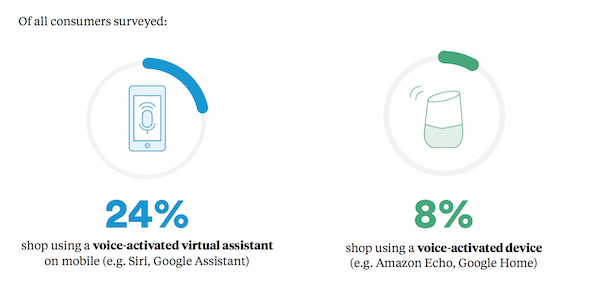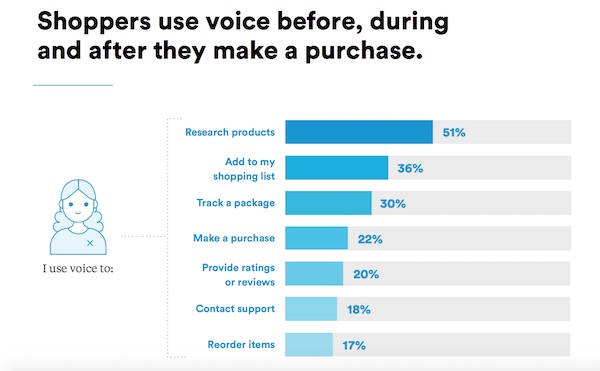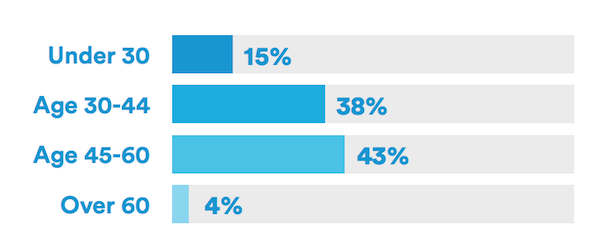One in four Online Shoppers Use Voice Assistants on Mobile to Shop
Retail software provider Narvar has published a report that says 24% of online shoppers use “voice-activated virtual assistants” on mobile to shop. The company also suggests 8% of online shoppers use voice-activated devices such as Amazon Echo and Google Home as part of their shopping path-to-purchase.

Source: Narvar November 2017
There has been a lot of discussion about shopping using voice assistants through smart speakers, but fewer data points related to mobile have been reported. The idea that digital shoppers are moving quickly to voice assistant support on mobile is an important development. Voice interaction is rapidly becoming well established in the home because of the popularity of smart speakers. The extension of these voice interaction habits forming in the home along with greater familiarity with voice search is logically extending into more voice interaction on mobile devices for a variety of use cases.
It is important to note that the survey was conducted online and only included online shoppers. This is a subset or a subset of total U.S. population. However, it is also a very large cohort. Online users in the U.S. is about 88.5% of the population and online shoppers account for about 80% of the total population. So, 24% of online shoppers using voice on mobile as part of their shopping path-to-purchase should roughly correlate to about 50 million U.S. adults.
Researching Products is Most Popular Voice Shopping Use Case
The Narvar study also looked at what voice use cases were common when shopping regardless of the input device. Researching products was the most popular at 51%. Using voice to manage shopping lists and track packages were next at 36% and 30% respectively. About one-in-five (22%) U.S. shoppers claim to have used voice to make a purchase and 17% to reorder items.

Source: Narvar November 2017
This is a valuable addition to the corpus of consumer voice technology adoption data in part because it delves into specific use cases. Voice shopping is about more than simply conducting a purchase transaction. Start-up Alpine AI is strictly focused on what it calls the “voice-enabled path-to-purchase.” The company focuses in this area because there are many ways voice technology in general and voice assistants in particular can help facilitate a purchase even if voice is not involved in consummating the final transaction. Alpine AI’s CEO Adam Marchick commented in a Voicebot interview earlier this year:
We have been engaged with a number of the top developers and first mover brands on the platform. Around Q4 of last year, we started to see some data movement around consumers asking voice-enabled devices about products. For example, what to buy and information about a product. We thought we could help create a solution to help with the purchase decision journey.
This sentiment aligns with findings from a Voysis report in 2017 that found 14% of retailers were investing in voice technologies and 55% were focused on “search and discovery” use cases.

Source: Voysis 2017
Voice Commerce is Growing Across Age Groups
This purchase journey use of voice complements a rising use for conducting transactions as well. Voicebot’s own research found that 26% of smart speaker owners had made a purchase though the devices and 11.5% were doing so monthly. Shopping, whether it is the path-to-purchase or the actual transaction is one of the most promising voice interactive use cases. And, the Narvar study points out:
It’s not just Millennials. Voice device owners of all ages use them to shop.

Source: Voice Shopping by Age Cohort – Narvar November 2017
Voice Shopping is Monthly Habit for 11.5% of Smart Speaker Owners








